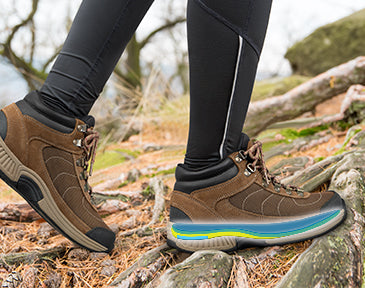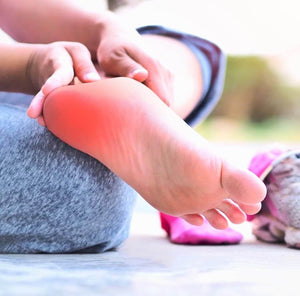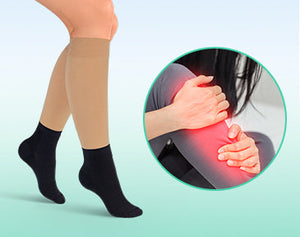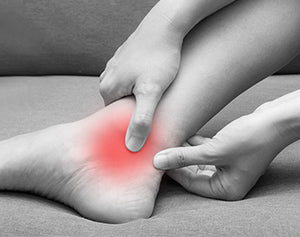The Orthofeet Blog
- All Posts
- All
- Arch Support
- Back Pain
- Bunions
- Diabetes
- Flat Feet
- Foot Pain
- Hammer Toes
- Heel Pain
- Heel Pain/ Heel Spurs
- Knee & Hip Pain
- Knee pain
- Morton Neuroma
- Orthopedic shoes
- Other
- Overpronation
- Plantar Fasciitis
- Swollen Feet
Plantar Fasciitis


Josh White DPM / August 12, 2021
Hiking with Plantar Fasciitis: What You Need to Know
Hiking with Plantar Fasciitis: What You Need to Know
Read Post-
9 Effective Ways to Alleviate Foot Pain from Standing All Day
Medical information provided by Josh White DPM / November 01, 2024Learn 9 effective ways to alleviate foot pain caused by standing all day, featuring Orthofeet’s orthopedic shoes designed for maximum comfort and support.Read More -
How to Prevent Bunions From Getting Worse
Medical information provided by Steven Gershman DPM / October 25, 2022Bunions are very common, but that does not mean they are a trivial issue. When it comes to severe bunions, they can evolve into a debilitating condition and even require surgery. If you have bunions, there are quite a few things you can do to prevent them from deteriorating. What is a Bunion? The medical term for a bunion is "Hallux Abducto Valgus “, or just "Hallux Valgus”. Bunions are a deformity of the big toe area of the foot that looks like a bony bump on the inside or medial side of the foot, just behind the big toe on the first metatarsal head, and the big toe angulates toward the second toe. Sometimes, the big toe actually overlaps the second toe or goes under it. The bump is actually the first metatarsal head that has shifted out away from the foot and widened it. This bump can enlarge due to inflammation from shoe pressure rubbing on it. Bunions can cause pain due to inflammation and poor shoe fitting. They can also lead to balance issues because they change the way your foot moves. This demonstrates how wearing the wrong shoes can cause balance problems, adding to the discomfort and difficulties caused by bunions. How Do Bunions Occur? Generally, bunions are a result of biomechanical flaws in the foot that are genetic or congenital. It is common to see bunions go from generation to generation, most commonly in women. Women are more prone to bunions, because they tend to have more flexible joints and ligaments, including in the foot, due to the necessity to give birth. This results in increased motion that allows any biomechanical flaws to be exacerbated, causing shifting of the bones and then bunions. Shoes can also be an issue. In addition, arthritis and other joint and connective tissue disorders can add to bunion formation. Do Bunions Get Progressively Worse? In most cases, bunions get worse gradually only if you don’t wear the right shoes and don’t get any treatment. Adequate shoes are critical to alleviating bunion pain and discomfort, and making sure they don’t become worse. While shoes alone don't cause bunion development, they can amplify the underlying biomechanical flaws. Shoe types such as dress shoes, high heels, pointed toe box and slip on shoes are all culprits. 4 Tips On How To Prevent Bunions From Getting Worse First, I want to point out one thing: bunions cannot be prevented if they are a result of a foot structure you were born with. However, the speed of formation and severity of deformity can be affected and slowed. All other causes of bunion development can be prevented with proper support and shoes. The underlying biomechanical issues we are born with are potent and cannot be changed easily. Once we put shoes on at a young age, we fundamentally change the shape and biomechanics of the foot forever. It’s like orthodontia for the teeth. Shoes immediately put pressure on the forefoot forcing the toes together and pushing the big toe inward, changing the anatomy, including the shape of the bones and the location of the cartilage. Looking at pictures of feet in some societies that never wear shoes, you can clearly see feet that look dramatically different than the feet that wear shoes. Without shoes, the toes are separated in a way that looks like a hand. Seeing as bunions can develop into a debilitating condition that might even require surgery, here are some tips on how to treat your bunions correctly, before they become too severe. 1. Don’t wear the wrong shoes Shoes can and do affect the severity of the anatomical changes that occur in bunion formation, and the associated symptomology. Basically, the more the shoe forces the big toe toward the second toe and allows excess motion, the worse the deformity. That’s why narrow pointed toe box shoes are a major factor. Unfortunately, many women's shoes are shaped that way for style. High heels are particularly damaging as they force the foot into an altered biomechanical position and jam the forefoot and big toe into the floor, shifting the big toe’s position. : 2. Orthotics are important As noted above, excess motion in the foot is one major cause of bunions and one cause of excess motion is over pronation. This issue, where the foot rolls inward excessively, is closely linked to flat feet. Understanding the causes of flat-foot overpronation is key to addressing both the symptom and its root cause effectively. Pronation is a natural motion the foot goes through as we walk and stand that loosens the foot. Pronation rolls the foot inward and drops the arch. This allows shock absorption and adaptation to changes in the terrain, so the foot can deal with uneven surfaces. In over pronation, the arch drops downward or inward excessively, found in many common foot problems. We can treat over pronation and the resulting excess motion it causes with orthotics in the shoes. Orthofeet designs well-made over the counter orthotics that are designed to support the arch, control over pronation, align the foot and correct the gait. I use a lot of these in practice and they have helped my patients tremendously. In more severe cases, a true rigid custom orthotic is required. Although there is no definitive proof of this, it is believed by many podiatrists that orthotics started early can significantly alter the severity of bunions and slow down the progression. 3. Know which shoes to look for In addition to orthotics, shoes are the other significant factor in bunion formation and severity. As noted above, shoes that have a narrow or pointed toe box are a major factor in speeding up and increasing severity of bunion formation. The best bunion shoes should be designed with the following features: Shoes for bunions need to have a wide, round and high toe box. The less pressure on the big toe, the better. Orthofeet shoes have a very round deep toe box with lots of room. I wear them myself, due to the comfort factor and since members of my family had severe bunions and I have the excess pronation and motion that could form bunions. If you already have bunions, the best shoes for bunions should have a round toe box and extra depth for the big toe, often being over or under the second toe. Also, extra depth shoes are critical, because they add stability and reduce motion, and can easily accommodate orthotics. Wide or extra wide shoes also are critical for bunions. Most shoes found today in big box stores only carry one width, usually medium, which is far from what a bunioned foot needs. The good news is that specialty footwear brands design shoes in extended widths - from narrow all the way up to extra extra wide! In many cases, bunion pain relief is as easy as wider shoes with a round toe box. The material of the shoes is very important for feet with bunions. Shoes constructed with tight and unforgiving materials will apply pressure on the bunion, worsen the condition and cause pain. However, comfortable shoes made with stretch knit uppers offer a relaxed fit and conform to the contours of your foot, specifically the bunion, to create a pressure free environment. Supple leathers can also work well. I have many patients with very wide feet from bunions who wear these after failing in most other shoes. Whatever material they are made of, it is important the upper is free of overlays or stitching across the sensitive bunion area. The interior of the shoe should be soft and padded to offer the utmost protection, preventing any further injury or friction to the painful area. Ideally, a seam free construction is best. Shoes for bunions should have a low heel or be flat to the ground to avoid forcing the forefoot into the floor, as is the case with heels. It’s also best to look for shoes that have an ergonomic sole with a mild rocker bottom that facilitates foot motion and transfers weight evenly from the rearfoot to the forefoot. 4. Other Bunion Relief Options Pain relief is key if you have a bunion and there are other options that are available for those who have minor cases of the condition. Bunions Socks. Bunion socks are not a means to prevent the deformity, but they can provide added benefits, such as separating the big toe from the remaining toes. This ensures the toes do not overlap and rub against each other, causing irritation. Orthofeet also offers bunion socks and they are super comfortable, as they’re made with soft bamboo fibers, offer a non-binding fit and wick moisture away from the foot. Bunion Pads. If you are looking to protect the bunion from anything that touches and rubs against it, bunion pads can help. Note that some pads are medicated with acid in them that can burn the skin. Do not use these! Simple protective pads will do the job just fine. How to Stretch Shoes for Bunions Although not my first choice and not as effective in treating and preventing bunions, there are some who like to make shoes wider for bunions by stretching them. The one useful device I have in the office to accommodate for the large bump of the bunion on the side of the foot is the Ball and Ring Stretcher. This device pushes out the toe box in one spot only, directly over the bony bump. Most podiatrists have this device and will be able to stretch your shoes if you bring them in. But, while stretching your shoes is helpful I want to reiterate that the best solution for people with bunions is to buy special shoes for bunions, like shoes for men with bunions and women’s bunion shoes, which come with all the design features I mentioned earlier: a wide toe box, soft stretchable uppers and special orthotic shoe inserts that provide arch support, reduce over pronation and help straighten the toes. See your podiatrist for more information and help with bunions. In the worst cases, surgery can correct bunions permanently. Surgery is the only true bunion treatment as it gets to the root of the problem.Read More -
How to Make Shoes Wider for Bunions
Medical information provided by Josh White DPM / September 22, 2022If you have bunions, you already know that too-tight shoes are an open invitation to lots of pain and discomfort. And to make matters worse, they will exacerbate the condition. If you own a pair of shoes that are too narrow for your feet and you suffer from bunions, you have two options: Stretch them so that they fit you more comfortably. Purchase shoes that are specifically designed for feet with bunions. How to Stretch Shoes for Bunions Take it to a shoemaker Naturally, shoemakers or shoe repair shops are skilled in stretching shoes, using professional tools and machines. Unfortunately, these shops are becoming more and more rare, but if you can find one in your area it can be a good solution. Use a professional shoe stretching tool Shoe stretchers usually come with a liquid or spray that you apply on your shoe before you insert the stretcher into it. Stretching liquids and sprays are available for a variety of shoe materials - fabric, leather and vinyl - and they loosen up the material, making the stretching process more effective. Once you insert the stretcher, you need to twist its widening handle to expand the shoe. Then, leave the shoe stretcher inside the shoe for 24 hours, until your shoes are wide enough. Apply heat This simple method is best used on shoes made from leather or suede, because other materials could be ruined by the heat. Before heating your shoes, put on a thick pair of socks and slip your feet into your shoes. Then, take a hair dryer, turn it on high and point the hot air toward the tight areas of your shoe. Continue blowing the hot air, while simultaneously stretching the shoe by wiggling and flexing your feet and toes. Once you’ve shut off the dryer, continue wearing your shoes with the thick socks for a little longer. Spray rubbing alcohol. First, mix 50% water with 50% rubbing alcohol and spray or rub it on your shoes. Next, wear the shoes immediately after treating them with the alcohol, repeating the process if necessary. However, don’t overuse the spray as it could damage the shoe fabric. This method works best on natural fabrics. Stuff your shoes with potatoes or wet newspapers. Take a potato large enough to stretch out your shoe, or wet newspapers that have expanded to a size large enough to stretch out your shoe, and insert them into your shoes. After two days, your shoes should be stretched out enough. Insert a bag of ice Fill freezable plastic bags with water, put them inside your shoes. Make sure the bags are completely sealed! Then, put the shoes in the freezer overnight. As the water freezes, it will expand and stretch out your shoe. When you remove the shoes and take out the bag in the morning, let your shoes dry before trying them on. Shop Now for Bunions Shoes Do tight shoes make bunions worse? The short answer is: yes! The more detailed answer is that bunions are usually caused by genetic or congenital biomechanical defects in the foot. Bunions are more common in women, because their joints and ligaments are more flexible, resulting in increased motion. This excess motion exacerbates the faulty foot structure, causing bones to shift and resulting in bunions. Bunions can also develop due to other foot conditions, such as flat feet and abnormal bone structure. If the problematic area of the bunions is jammed in the shoe, as is the case with shoes that are too tight, the forefoot is pushed forward into the toe box. This crowds the toes, applies pressure on the big toe, exacerbates the defective foot structure and worsens the symptoms of bunions. “Although preventing bunions is not possible, shoes can and do affect the severity of the anatomical changes that occur in bunion formation and the associated symptomology,” explains Dr. Steven Gershman, a podiatrist. “Basically, the more the shoe forces the big toe toward the second toe and allows excess motion, the worse the deformity”. Still, tight shoes are not the only culprit and there are other causes that can make things worse for your bunions: High heel shoes and narrow pointed shoes that also crowd the toes. Spending long hours on your feet. Foot conditions such as arthritis, overpronation, flat feet and more. Can shoes be stretched to accommodate bunions? Bunions create a bump on the interior side of the foot, just under the big toe, angulating the big toe toward the second toe. Naturally, this bump adds width to the foot and can become larger due to pressure applied by the shoe. So basically, bunions don’t only cause pain and even balance issues, but can also make it hard to find shoes that fit properly. Stretching shoes to accommodate bunions can help and you can even find good stretchers that push the toe box in one specific spot, directly over the bump of the bunion. But, although stretching can help, the width of the shoe is not the only factor to take into account when looking for shoes that are best for bunions. Why it's better to buy shoes for bunions rather than stretch them? We’ve already established that increased motion in the foot is a major cause of bunions, while various foot conditions, such as overpronation, can make matters worse. So, buying shoes that help address these issues can also help your bunions. More specifically, good quality orthotics that support the arch, align the foot, help straighten the toes and correct the gait, can treat overpronation and the increased motion it causes, and therefore alleviate bunion symptoms, pain and discomfort. Moreover, using orthotics in the early stages of bunions is believed by many podiatrists to significantly slow down the progression of the bunions. But orthotics are not the only design feature that can treat and even prevent bunions. Look for the following design features and shoes: Wide enough front to accommodate your toes and bunions comfortably. The best toe box for bunions is wide, high and round, with extra depth for the big toe. Extra depth shoes also allow you to insert custom orthotics if you need to, and help reduce excess motion. Wide width shoes that, together with the deep toe box, can make all the difference to your bunions, provide relief and prevent the bunions from getting worse. Shoes made from a stretchy material that eliminates pressure on the bunions. The best pressure-free material would be one that can not only stretch, but also conform to the contour of your foot and bunion. Shoes with straps or laces that allow you to adjust the fit if you need to, because the size of your bunion can change over time and even during the day. Low heels or flat shoes that don’t push your feet into the ground, applying pressure on your toes. Ergonomic sole, preferably with a mild rocker bottom that decreases joint movement and disperses the pressure evenly across the foot. Finally, here’s a tip on how to lace shoes for bunions. Use the bunion step-over technique. With this technique, you simply bypass the eyelet that overlays your big toe joint. This lacing method significantly minimizes the pressure on the bunion.Read More








